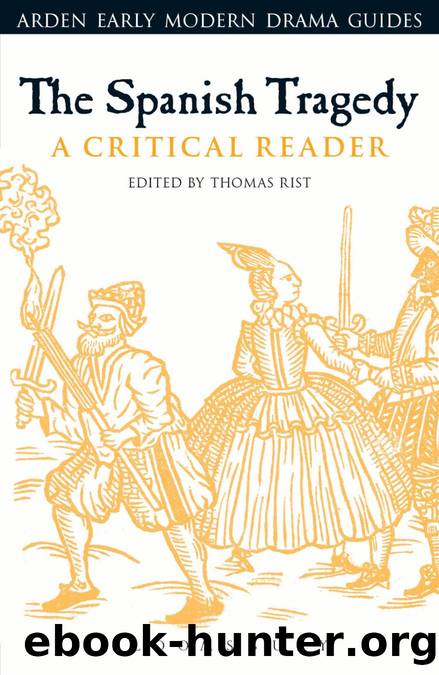The Spanish Tragedy by Rist Thomas;Hiscock Andrew;Hopkins Lisa;

Author:Rist, Thomas;Hiscock, Andrew;Hopkins, Lisa;
Language: eng
Format: epub
Tags: A Critical Reader
Publisher: Bloomsbury Publishing Plc
Published: 2019-11-23T00:00:00+00:00
6
New Directions: The Spanish Tragedy and Virgil
Tom Rutter
Although Hieronimoâs grief for his son Horatio, and his struggle to achieve justice for him, are the emotional and thematic focus of The Spanish Tragedy, Kyd also supplies the play with a framing device of unusual prominence and detail: the story of Don Andrea, whose words introduce and conclude the action and who watches it unfold, providing occasional comment and thus serving along with Revenge as âchorus in this tragedyâ (1.1.91). In the opening scene, Andreaâs Ghost briefly summarizes his birth, life at court, love for Bel-imperia, and death in the war against Portugal. He then offers a more detailed account of his soulâs descent to the Underworld, the disagreement between Minos, Aeacus and Rhadamanth over where he should spend eternity, and the decision of Proserpine that he should return to the upper world where, in the words of Revenge, he is to see
the author of thy death,
Don Balthazar, the Prince of Portugal,
Deprived of life by Bel-imperia. (1.1.87â9)
At this point the tragedy proper begins with the entry of the Spanish King and the other characters.
Kydâs decision to open The Spanish Tragedy with speeches from a Ghost accompanied by Revenge was probably suggested by the practice of the first-century dramatist Seneca (see Gordon Bradenâs chapter in this collection), whose Thyestes begins with an exchange between the Ghost of Tantalus and a Fury in which the bloody events of the play are anticipated and whose Agamemnon, in turn, opens with a speech from the Ghost of Thyestes. However, the details of Andreaâs posthumous journey show the clear influence of an earlier Latin poet, namely Publius Vergilius Maro or Virgil (70 bcâ19 bc), whose twelve-book epic the Aeneid includes a description of the heroâs descent to the Underworld. The current chapter surveys some of the ways in which Kydâs use of Virgil has been understood by critics, before considering his play in the light of two texts from his own era that seem to address the broader question of how popular drama should position itself in relation to the classical tradition of which Virgil was a part: Thomas Nasheâs Preface to Menaphon and Christopher Marloweâs Doctor Faustus.
*
In book 6 of Virgilâs poem, the hero, Aeneas, whose wanderings by sea after fleeing the destruction of Troy have finally brought him to Italy, is led by the prophetic Sybil into the land of the dead. Here he encounters former comrades, is told of the punishments suffered by evildoers, speaks with his dead father Anchises, and sees a vision of the future foundation and history of Rome before returning to the world of the living. This sequence provides considerable material that finds its way into Andreaâs narrative. The ferryman Charonâs insistence that with Andreaâs ârites of burial not performed, | I might not sit amongst his passengersâ (1.1.21â2) recalls the fate of Aeneasâs friend Palinurus, unable to cross the river Styx while his body remains unburied. The Sybil helps Aeneas past the three-headed guard-dog Cerberus with the help of drugged honey, while Andrea talks of âpleasing Cerberus with honeyed speechâ (1.
Download
This site does not store any files on its server. We only index and link to content provided by other sites. Please contact the content providers to delete copyright contents if any and email us, we'll remove relevant links or contents immediately.
The Evolution of an Empire: A Brief Historical Sketch of France by Mary Platt Parmele(405)
An Introduction to the Philosophy of Law by Unknown(295)
Astounding Stories, August, 1931 by Various Authors(293)
B-12's Moon Glow by Charles A. Stearns(287)
Historia Amoris by Edgar Saltus(279)
Arsene Lupin vs. Herlock Sholmes by Maurice Leblanc(270)
The Fade Tabletop by Jeremy Harris(260)
The Scottish Fairy Book by Elizabeth W. (Elizabeth Wilson) Grierson(258)
The Courtship of Morrice Buckler by A. E. W. Mason(236)
BY Arthur H. Smith, Smith A.H. by Village life in china(233)
Memoirs of a Veteran: Personal Incidents, Experiences and Observations by Isaac Hermann(229)
The story of Sigurd the Volsung and the fall of the Niblungs by William Morris by Unknown(226)
Euthenics, the science of controllable environment by Ellen H. (Ellen Henrietta) Richards(219)
Cottage Economy, to Which is Added The Poor Man's Friend by William Cobbett(218)
A History of Witchcraft in England from 1558 to 1718 by Wallace Notestein(218)
Folk-Tales of the Khasis by Mrs. Rafy(213)
The Black Douglas by S. R. Crockett(209)
Humphrey, Duke of Gloucester: A Biography by Kenneth Hotham Vickers(202)
Behind The Black Dome: An Advantage Player's Guide to Casino Surveillance by T. Dane(198)
